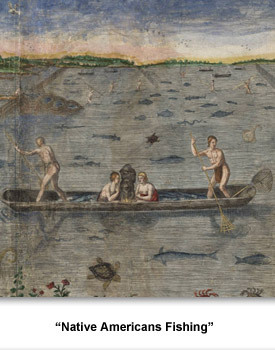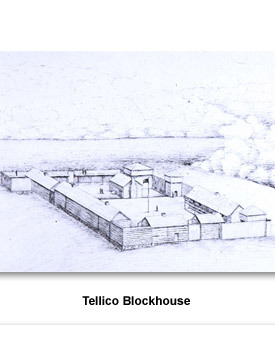Trade
archaeologists have found many exotic materials, such as seashells from the Gulf Coast and Canadian stones, across the middle South. The presence of these materials has led archaeologists to believe that informal trade networks existed among Native Americans as early as 5,000 B. C.
Native Americans used established trails to travel from village to village in order to trade. Such trails probably began as routes used by animals during migrations while others may have began as paths that followed a particular river. By the 16th century hunting, fishing, and trading helped the development of these trails as well as contact between tribes native to Tennessee and tribes west of the Mississippi River.
The most important exchanges occurred between the seacoast and the interior. Seashells were highly valued in inland areas, while deerskins were greatly prized along the coast. Famous trade routes such as the Great Indian War Path connected southern and northern tribes from Pennsylvania to Georgia, and the Old Chickasaw Trace, later known as Natchez Trace, connected tribes from Tennessee to Mississippi.
After the French and English established trade routes throughout Tennessee in 1673, the Indians’ experience at hunting provided them with new opportunities.
Originally many Europeans came to the colonies to find silver and gold. They instead found deer and beaver, whose pelts were nearly as valuable in European markets. To the Europeans, the land of North America was a source of wealth.
The Indians participated by trading with the Europeans. After the Europeans arrived, Indians supplied the English and French with animal pelts in exchange for European tools, equipment, and weapons.
By the late 17th century the Choctaw were actively trading horses originally acquired from New Mexico. This new technology rapidly expanded the Choctaw’s deerskin trade with the French and the British.
Traders also encouraged another sort of trade that wasn’t so good—a trade in humans. Europeans would purchase captives that their trading partners had taken in battle and use them for slave labor. Since the owners worried about the Indian slaves easily escaping, many of these Indian slaves were sold to plantation owners in the West Indies.Picture Credits:
- Contemporary drawing of the “Tellico Blockhouse.” The Tellico Blockhouse was built in 1794 as a Federal outpost in Monroe County, Tennessee. The blockhouse served as a trading and military post from 1794 until 1807. This drawing is based upon research conducted by the University of Tennessee archaeologists at Overhill Cherokee sites. Frank H. McClung Museum, University of Tennessee.
- Drawing featuring “Native Americans Fishing.” The image shows four Native Americans in a canoe. Two are fishing with spears, while two others tend a fire burning in the middle of the canoe. Many fish are visible in the water as well as crabs, turtles, and sharks. Originally drawn by John Whyte this picture was included in the book A Briefe and True Report of the New Found Land of Virginia by Thomas Hariot. Later the image was engraved by Theodor de Bry and reprinted in 1590. De Bry wanted to make Native Americans look more like Europeans, so he drew them with blonde hair and white skin. Although the drawing is not entirely accurate, it demonstrates how some Europeans did not understand or appreciate the ways in which Native Americans were different from them. The Indians pictured belong to the Southern Algonquian group of Indians, who are related to the Shawnee. North Carolina Collection, University of North Carolina.
Indians & Cultural Encounters >> Indian Life >> How They Worked >> Trade


 Sponsored by: National Endowment for the Humanities
Sponsored by: National Endowment for the Humanities